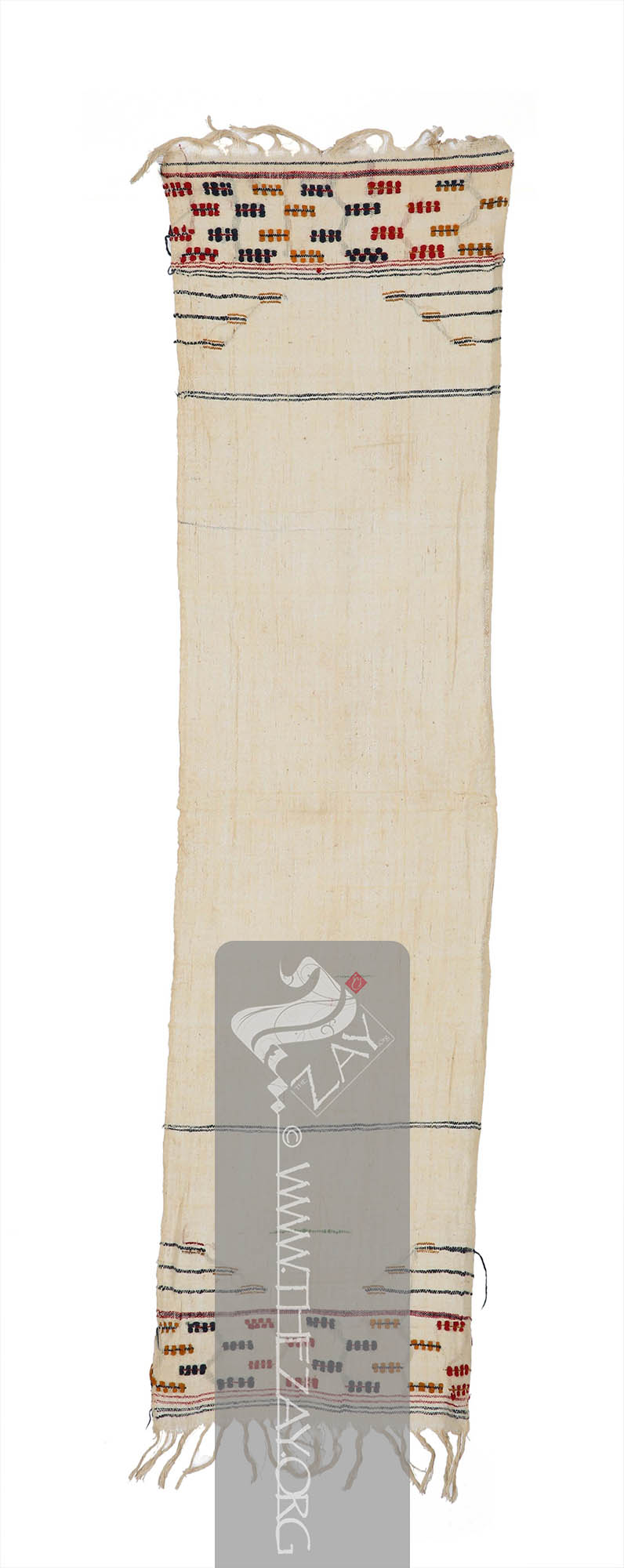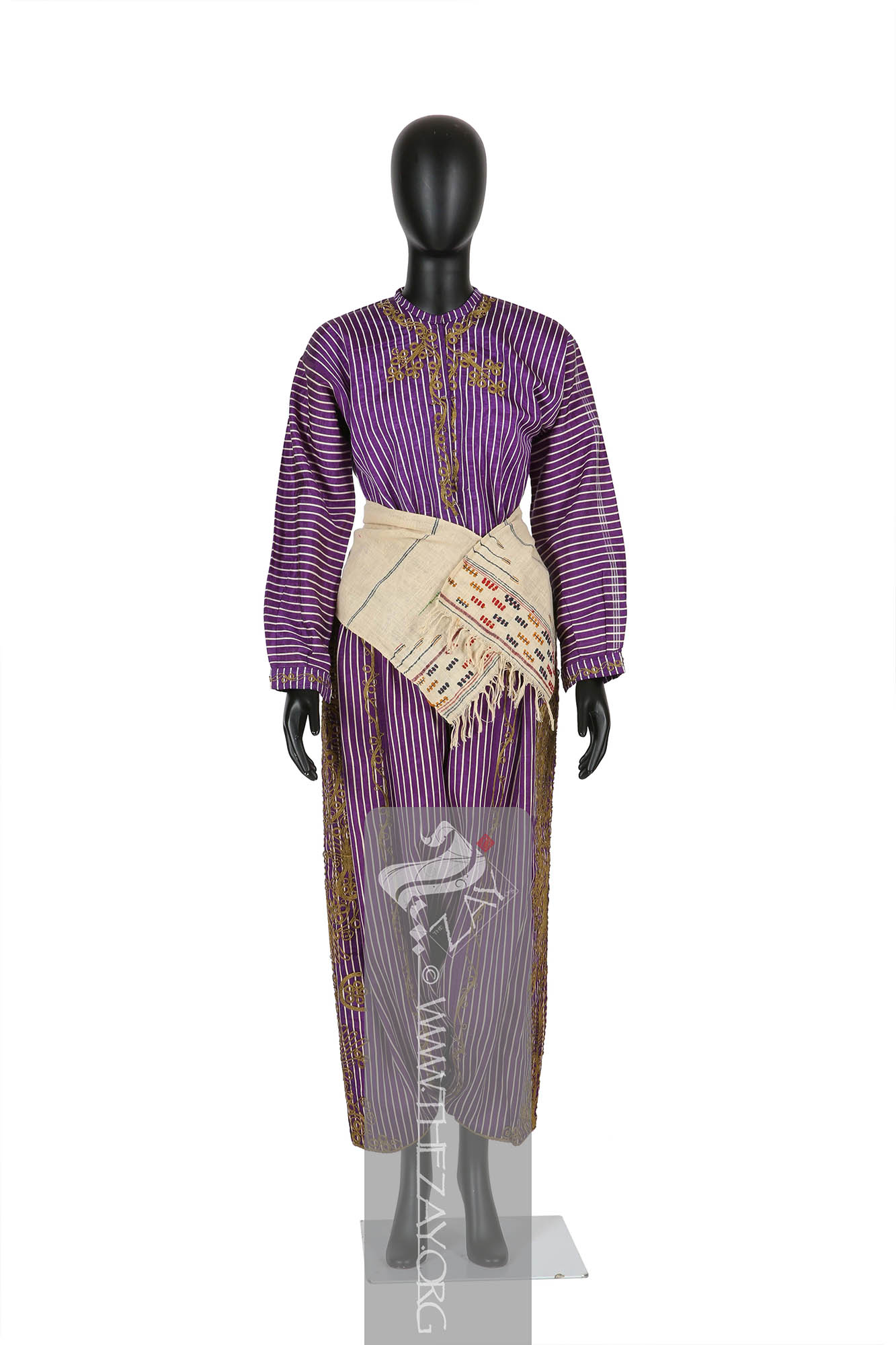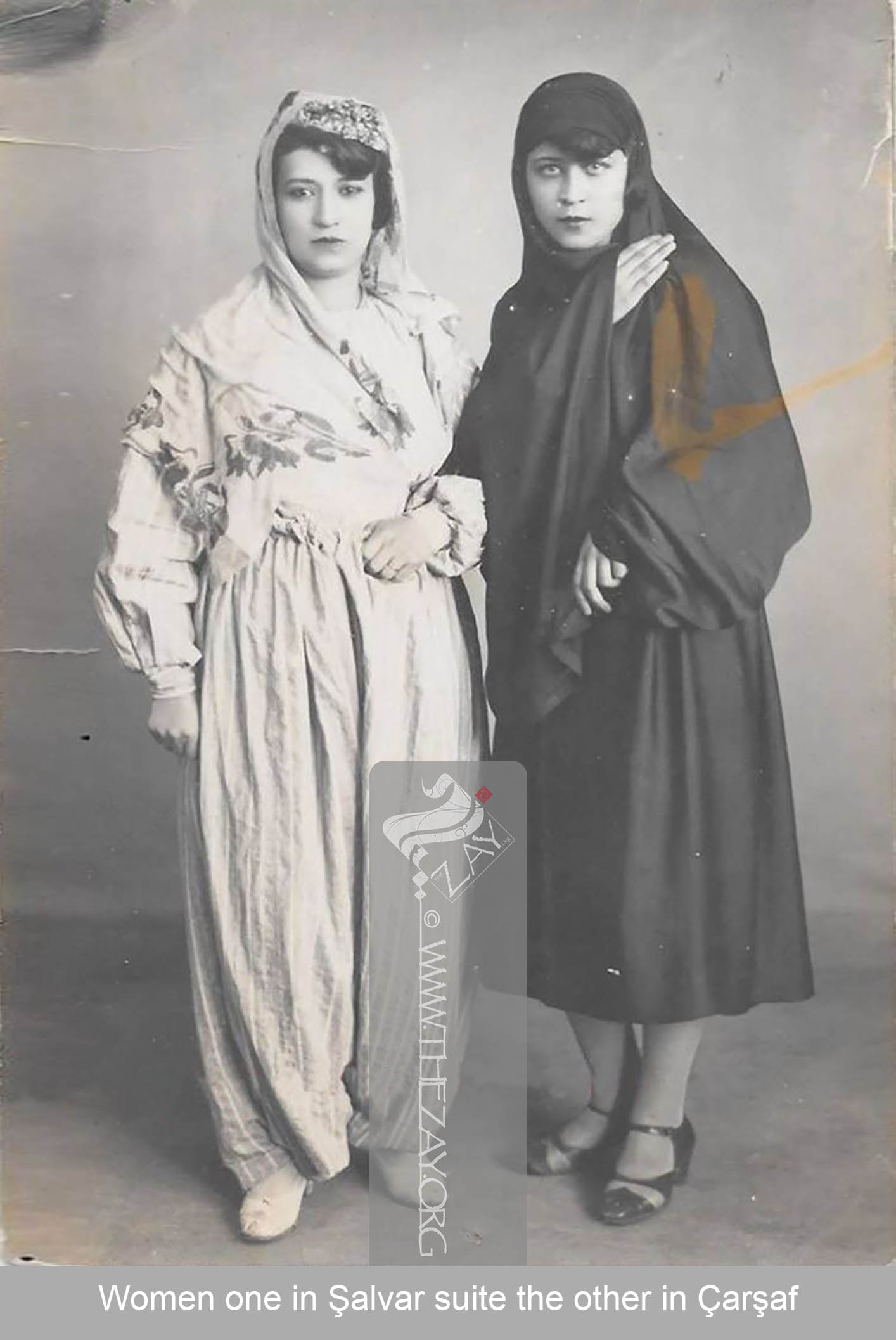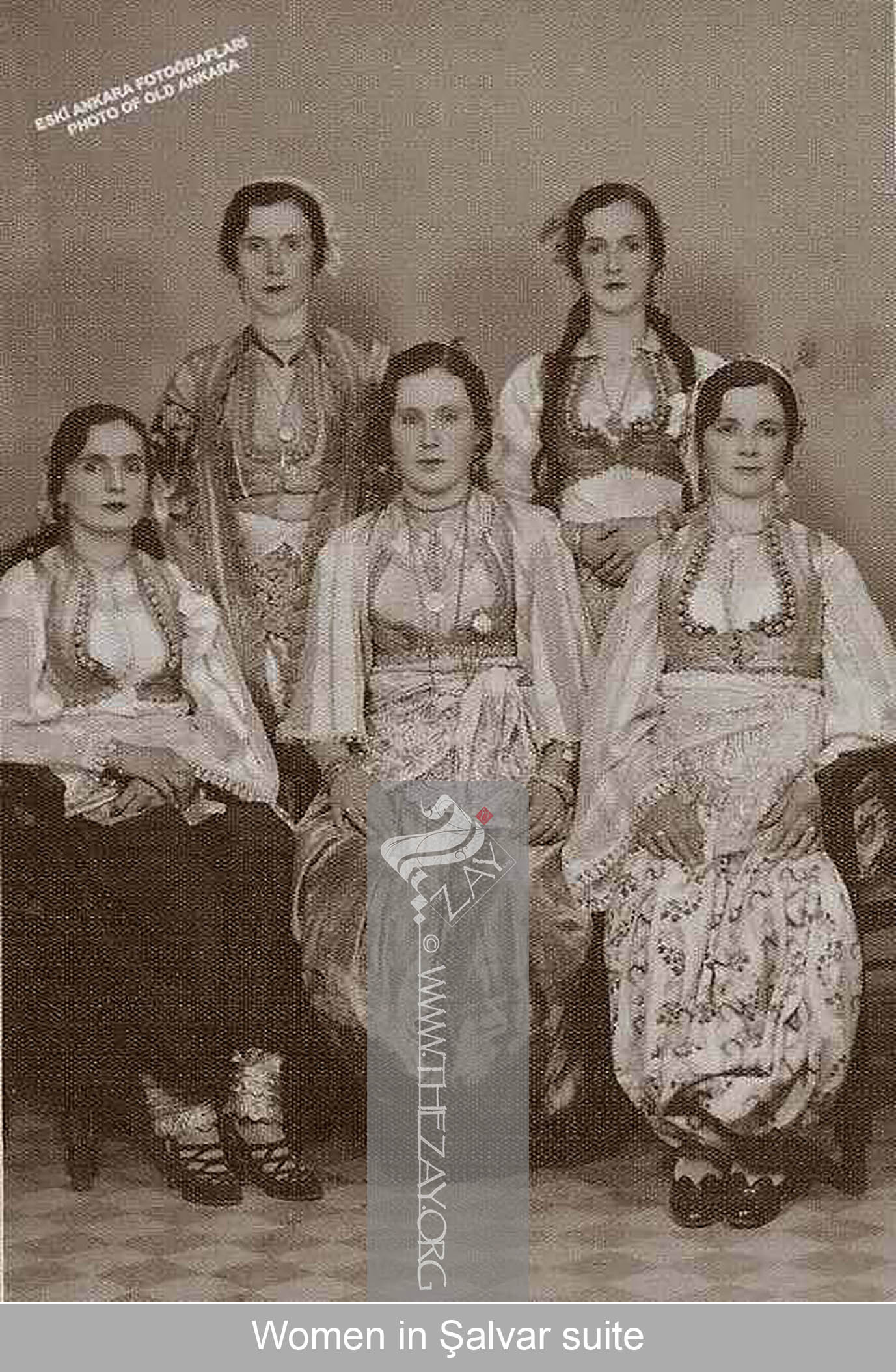Object NotePart of an ensemble with two other pieces also part of the collection (
ZI2021.500875.1 ASIA and
ZI2021.500875.1a ASIA).
Object History This piece of garment was purchased by
Dr. Reem Tariq
Ṭariq: (Arabic; Synonym: tulle_bi_talli
Tūlle_bi_tallī: (French: Tulle – a city in France where fine material for veil was first made; Turkish: tel – wire; Synonym: tariq; talli; badla; khus_dozi ), series of small metal knots made on a woven net ground as embellishment. The term is commonly used in the North African Arab region specifically in Egypt.
; talli; badla; khus_dozi ), series of small metal knots made on a woven net ground as embellishment. The term is commonly used in the Levant Arab region specifically in Lebanon.
El Mutwalli
Dr. Reem Tariq
Ṭariq: (Arabic; Synonym: tulle_bi_talli
Tūlle_bi_tallī: (French: Tulle – a city in France where fine material for veil was first made; Turkish: tel – wire; Synonym: tariq; talli; badla; khus_dozi ), series of small metal knots made on a woven net ground as embellishment. The term is commonly used in the North African Arab region specifically in Egypt.
; talli; badla; khus_dozi ), series of small metal knots made on a woven net ground as embellishment. The term is commonly used in the Levant Arab region specifically in Lebanon.
el Mutwallī: Founder (CEO) of the Zay
Zay: (Arabic: costume, Pl. azyaā’), a set of clothes in a style typical of a particular country or historical period. Initiative, a public figure, speaker and author. An expert curator and consultant in Islamic art and architecture, interior design, historic costume, and UAE heritage. as a set of ensembles from a dealer, in Istanbul in 2021 to add to and enhance The
Zay
Zay: (Arabic: costume, Pl. azyaā’), a set of clothes in a style typical of a particular country or historical period. Initiative Collection.
Object Features This is an ivory cotton
gauze
Gauze: (English), very fine wire mesh transparent fabric of silk, linen, or cotton. decorative towel (
yaglik
Yaglik: (Proto Turkic: yaglik – kerchief, head scarf), an embroidered textile, traditionally rectangular in shape, used for household decoration or special occasions. Originally referring to napkins made of cotton or linen, it evolved to include ornate embroidery, particularly favoured by young brides in their trousseau. ) woven and embellished with embroidery making it a waistband (
kusak
Kusak: (Turkish), a wide belt, sash or girdle worn around the waist to secure clothing. Typically made of fabric, leather, or embroidered material, it serves both practical and decorative purposes by adding a touch of elegance to traditional Ottoman attire. ) too.
The piece is woven (
selvedge
Selvedge: (English: Self-finished edge or self-edge: a dialect forming transition), an edge produced on woven fabric during manufacture that prevents it from unravelling. Traditionally the term selvage applied to only loom woven fabric, presently it could be applied to flat knitted fabric too. ) to
selvedge
Selvedge: (English: Self-finished edge or self-edge: a dialect forming transition), an edge produced on woven fabric during manufacture that prevents it from unravelling. Traditionally the term selvage applied to only loom woven fabric, presently it could be applied to flat knitted fabric too. in ivory cotton with sporadic horizontal lines parallel to one another in
indigo
Indigo: (Latin: Indigo – India, synonym: nil
Nīl: (Latin: indigo), Arabised term for Indigo, a natural dye belonging to the ‘Indigofera Tinctoria’ species of plants that have been cultivated in East Asia, Egypt, India, and Peru since antiquity. According to Pliny the Elder, it was named after India as it was the source of the dye.), a natural dye belonging to the ‘Indigofera Tinctoria’ species of plants that has been cultivated in East Asia, Egypt, India, and Peru since antiquity. According to Pliny the Elder, it was named after India as it was the source of the dye. blue and (
ochre
Ochre: (Greek: ōkhra – Yellow Ochre), is a natural earth pigment that ranges in colour from yellow to red-brown, often used in art and decoration. ) yellow woollen threads.
The (
warp
Warp: One of the two basic components used in weaving which transforms thread or yarns to a piece of fabric. The warp is the set of yarns stretched longitudinally in place on a loom before the weft
Weft: one of the two basic components used in weaving that transforms thread or yarns into a piece of fabric. It is the crosswise thread on a loom that is passed over and under the warp threads. is introduced during the weaving process. ) ends of the
yaglik
Yaglik: (Proto Turkic: yaglik – kerchief, head scarf), an embroidered textile, traditionally rectangular in shape, used for household decoration or special occasions. Originally referring to napkins made of cotton or linen, it evolved to include ornate embroidery, particularly favoured by young brides in their trousseau. have four parallel lines in blue and (
crimson
Crimson: (Persian/Arabic and Turkish: qirmiz or kirmiz – red), is a vivid red color originally made from the dried bodies of a scale insect of the Kermes genus native to the Mediterranean region and was used as a dye for clothing and textiles.) red and a broad panel with embroidered patterns featuring geometric shapes in blue, red and yellow followed by a thick red and blue woven line and a thinner blue line. The
warp
Warp: One of the two basic components used in weaving which transforms thread or yarns to a piece of fabric. The warp is the set of yarns stretched longitudinally in place on a loom before the weft
Weft: one of the two basic components used in weaving that transforms thread or yarns into a piece of fabric. It is the crosswise thread on a loom that is passed over and under the warp threads. is introduced during the weaving process. ends are kept loose to form a series of hanging fringes.
More Info
In Turkish parlance, the term
yaglik
Yaglik: (Proto Turkic: yaglik – kerchief, head scarf), an embroidered textile, traditionally rectangular in shape, used for household decoration or special occasions. Originally referring to napkins made of cotton or linen, it evolved to include ornate embroidery, particularly favoured by young brides in their trousseau. originally denoted a rectangular piece of cotton or linen, available in various sizes, used primarily as a napkin. Often, both ends of the
yaglik
Yaglik: (Proto Turkic: yaglik – kerchief, head scarf), an embroidered textile, traditionally rectangular in shape, used for household decoration or special occasions. Originally referring to napkins made of cotton or linen, it evolved to include ornate embroidery, particularly favoured by young brides in their trousseau. were embellished with embroidery.
Over time, the term expanded in meaning to encompass embroidered textiles used for decorative purposes within the household or during special occasions. Young brides frequently included
yaglik
Yaglik: (Proto Turkic: yaglik – kerchief, head scarf), an embroidered textile, traditionally rectangular in shape, used for household decoration or special occasions. Originally referring to napkins made of cotton or linen, it evolved to include ornate embroidery, particularly favoured by young brides in their trousseau. that was endearingly crafted by themselves and other members of their family in their trousseau as cherished possessions.
However, sashes with embroidery perhaps were not as prominent prior to the 18th century as embroidery in Ottoman Turkey until then, primarily emulated the luxurious woven silks and velvets found in courtly textiles.
Ottoman embroidery began to be recognized as an independent art form only after the first quarter of the 18th century when it deviated from the replication of woven designs and embraced a more creative approach. This shift included new and naturalistic floral motifs that flowed more freely across the design field.
Simultaneously an examination of historical artworks from Iran reveals a progressive evolution in the style of waist girdles which eventually evolved into an Ottoman
kusak
Kusak: (Turkish), a wide belt, sash or girdle worn around the waist to secure clothing. Typically made of fabric, leather, or embroidered material, it serves both practical and decorative purposes by adding a touch of elegance to traditional Ottoman attire. .
During the early 16th century, it was customary for individuals in Iran to wear a leather strap adorned with metal plaques. Subsequently, this design gave way to a narrower textile band fastened with gold clasps.
Thomas Herbert, a member of an English embassy to Iran in the late 1620s, made noteworthy observations regarding the length of these sashes and the significant variations in their materials.
According to him individuals of different social statuses distinguished themselves through the quality of their band and the accompanying plain, but opulent fabric towels used underneath them. These fabrics were often made of silk and gold for nobilities, while the merchants wore them woven with silver and lower-ranking individuals wore them in silk and wool.
Similar sashes were also prevalent in the realms, adjacent to the Safavid cultural sphere – Ottoman and Mughal. By the late 17th century, this fashion trend had not just been widely accepted in the Ottoman Empire but transcended beyond it. It had reached parts of eastern Europe, such as Poland and Russia.
Thus, the courtiers in these regions embraced the use of textiles and fashion trends imported from Ottoman Turkey as status symbols. While the style of dress amongst the aristocracy in this region as well as the Ottoman empire gradually started drawing inspiration from the West, the popularity of the sash endured as an indelible mark of Ottoman influence either as an elaborate buckled
kusak
Kusak: (Turkish), a wide belt, sash or girdle worn around the waist to secure clothing. Typically made of fabric, leather, or embroidered material, it serves both practical and decorative purposes by adding a touch of elegance to traditional Ottoman attire. or as an daintily embroidered
yaglik
Yaglik: (Proto Turkic: yaglik – kerchief, head scarf), an embroidered textile, traditionally rectangular in shape, used for household decoration or special occasions. Originally referring to napkins made of cotton or linen, it evolved to include ornate embroidery, particularly favoured by young brides in their trousseau. .
Links
- Cangökçe, Hadiye, et al. Osmanlı İmparatorluğu’nun Son Döneminden Kadın Giysileri = Women’s Costume of the Late Ottoman Era from the Sadberk Hanım Museum Collection. Sadberk Hanım Museum, 2010.
- Küçükerman, Önder, and Joyce Matthews. The Industrial Heritage of Costume Design in Turkey. GSD Foreign Trade Co. Inc, 1996.
- AĞAÇ, Saliha, and Serap DENGİN. “The Investigation in Terms of Design Component of Ottoman Women Entari
: (Turkish; Synonym: Antari), a traditional Turkish long jacket-like unisex garment worn during the Ottoman era. It often featured an open front with long sleeves and was worn over an undershirt and a pair of trousers and was sometimes layered by a short waist or hip-length jacket. in 19th Century and Early 20th Century.” International Journal of Science Culture and Sport (IntJSCS), vol. 3, no. 1, Mar. 2015, pp. 113–125. https://dergipark.org.tr/tr/download/article-file/91778
- Parker, Julianne. “OTTOMAN AND EUROPEAN INFLUENCE IN THE NINTEENTH-CENTURY BRIDAL COLLECTION OF THE AZEM PALACE, DAMASCUS, SYRIA.” Journal of Undergraduate Research: Brigham Young University, 18 Sept. 2013. http://jur.byu.edu/?p=6014
- Koç, Adem. “The Significance and Compatibility of the Traditional Clothing-Finery Culture of Women in Kutahya in Terms of Sustainability.” Milli Folklor , vol. 12, no. 93, Apr. 2012. 184. https://www.millifolklor.com/PdfViewer.aspx?Sayi=93&Sayfa=181
- Micklewright, Nancy. “Late-Nineteenth-Century Ottoman Wedding Costumes as Indicators of Social Change.” Muqarnas, vol. 6, 1989, pp. 161–74. JSTOR, https://doi.org/10.2307/1602288. Accessed 13 July 2023.
- Micklewright, Nancy. “Looking at the Past: Nineteenth Century Images of Constantinople and Historic Documents.” Expedition, vol. 32, no. 1, pp. 24–32. https://www.penn.museum/documents/publications/expedition/pdfs/32-1/micklewright.pdf
- Ozgen, Ozlen, et al. “Henna Ritual Clothing in Anatolia from Past to Present: An Evaluation on Bindalli.” Textile Society of America Symposium Proceedings, 2021, https://doi.org/10.32873/unl.dc.tsasp.0122.
- https://artsandculture.google.com/story/traditional-jewellery-and-dress-from-the-balkans-the-british-museum/ZQXB8B6bvfnaKw?hl=en
- https://www.metmuseum.org/art/collection/search/227446
- https://www.metmuseum.org/art/collection/search/443074
- https://www.trc-leiden.nl/trc-needles/individual-textiles-and-textile-types/daily-and-general-garments-and-textiles/yagliks









